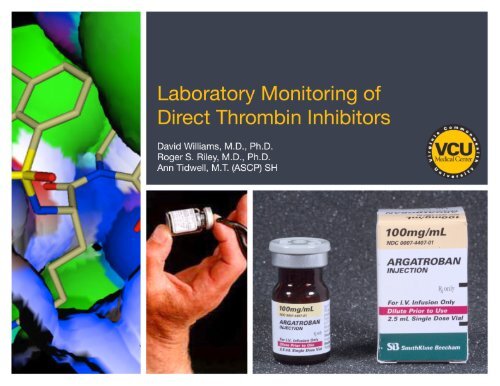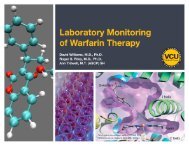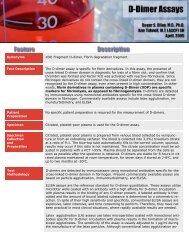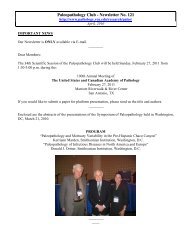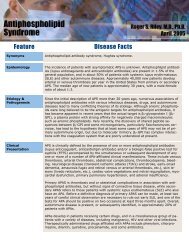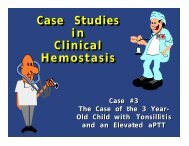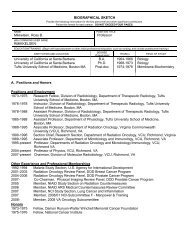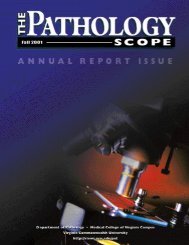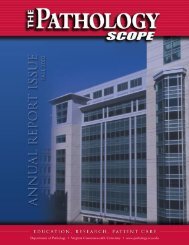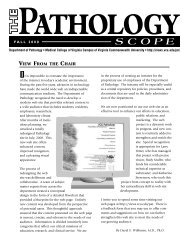Laboratory Monitoring of Direct Thrombin Inhibitors - Pathology
Laboratory Monitoring of Direct Thrombin Inhibitors - Pathology
Laboratory Monitoring of Direct Thrombin Inhibitors - Pathology
Create successful ePaper yourself
Turn your PDF publications into a flip-book with our unique Google optimized e-Paper software.
<strong>Laboratory</strong> <strong>Monitoring</strong> <strong>of</strong><br />
<strong>Direct</strong> <strong>Thrombin</strong> <strong>Inhibitors</strong><br />
David Williams, M.D., Ph.D.<br />
Roger S. Riley, M.D., Ph.D.<br />
Ann Tidwell, M.T. (ASCP) SH
<strong>Direct</strong> <strong>Thrombin</strong> <strong>Inhibitors</strong><br />
! <strong>Direct</strong> thrombin inhibitors (DTIs) are<br />
anticoagulants with a targeted specicity for<br />
thrombin. DTIs have a predictable anticoagulant<br />
effect with little interindividual variability,<br />
since they do not interact with platelets<br />
or plasma proteins and do not require<br />
antithrombin as a c<strong>of</strong>actor. Hirudin is a natural<br />
65 amino acid DTI produced by the salivary<br />
glands <strong>of</strong> the medicinal leech. Recombinant<br />
hirudin (i.e., lepirudin) and smaller<br />
synthetic analogs <strong>of</strong> hirudin (i.e., hirulog,<br />
bivalirudin) constituent the divalent DTIs<br />
that interact with both the catalytic and substrate<br />
recognition site <strong>of</strong> thrombin. Monovalent<br />
DTIs include several small molecules<br />
(i.e., agratoban, melagatran, ximelagatran)<br />
that interact only with thrombin’s catalytic<br />
site. The requirement for laboratory monitoring<br />
<strong>of</strong> DTIs varies with the individual<br />
agent. Although relatively new, the many<br />
medical advantages <strong>of</strong> the DTIs portend<br />
their widespread use in the near future for<br />
thrombophylaxis, stroke prevention, and the<br />
treatment <strong>of</strong> venous thromboembolic disease<br />
and heparin-induced thrombocytopenia.<br />
There are two general classes <strong>of</strong> direct<br />
thrombin inhibitors: divalent inhibitors that<br />
bind both the substrate recognition site (exosite<br />
1) and the catalytic site <strong>of</strong> thrombin and<br />
monovalent inhibitors that bind only the catalytic<br />
site. Members <strong>of</strong> the bivalent class currently<br />
available include lepirudin and desirudin<br />
(recombinant forms <strong>of</strong> the leech extract<br />
hirudin) and bivalirudin. Members <strong>of</strong> the<br />
monovalent class include the currently available<br />
argatroban and the recently developed<br />
ximelgatran, which is not yet approved by the<br />
FDA.<br />
Class 1<br />
Desirudin, Lepirudin, and Bivalirudin<br />
Recombinant desirudin and lepirudin,<br />
are 65 amino acids, roughly 7 kDa, polypeptides<br />
that differ from hirudin by sulphation <strong>of</strong><br />
a C-terminal tyrosine and from one another<br />
by an isoleucine to a leucine change. The<br />
amino terminal portion <strong>of</strong> the polypeptide<br />
forms a globular domain that binds to the<br />
catalytic site <strong>of</strong> thrombin, while the carboxy<br />
terminal twelve residues form an extended<br />
strand that interacts with the fibrinogen binding<br />
exosite 1. These peptides bind irreversibly<br />
to thrombin and inhibit cleavage <strong>of</strong> fibrinogen<br />
to fibrin. Binding to substrate requires<br />
access to exosite 1, hence these peptides do<br />
not inhibit thrombin that is already bound to<br />
fibrinogen.<br />
Bivalirudin is a 20 amino acid derivative<br />
<strong>of</strong> hirudin. The amino terminus consists<br />
<strong>of</strong> the active site inhibitory sequence, D-Phe-<br />
Pro-Arg, which is connected by a flexible<br />
Fig. 1. Hirudin bound to thrombin. The crystal structure<br />
<strong>of</strong> thrombin bound to recombinant hirudin (pdb<br />
code: 4HTC) is shown. <strong>Thrombin</strong> is depicted as a surface<br />
model colored salmon with the active site triad<br />
colored green. The inhibitor hirudin is shown as a ribbon<br />
model. Residues that also form the C-terminal<br />
portion <strong>of</strong> bivalirudin are colored cyan and the remaining<br />
residues are colored blue.<br />
Structure & Metabolism 2
<strong>Direct</strong> <strong>Thrombin</strong> <strong>Inhibitors</strong><br />
Fig. 2. Argatroban bound to thrombin. The crystal<br />
structure <strong>of</strong> thrombin bound to argatroban (pdb<br />
code: 1DWC) is shown. <strong>Thrombin</strong> is depicted as a surface<br />
model colored salmon with the active site triad<br />
colored green. The inhibitor argatroban is shown in a<br />
stick model colored by atom type. The peptide fragment<br />
from hirudin present in the crystal structure is<br />
omitted from this figure for clarity.<br />
tetra-glycine linker to twelve amino acids<br />
from the carboxy terminus <strong>of</strong> hirudin that<br />
bind to exosite 1. The Pro-Arg peptide bond<br />
can be slowly cleaved by the catalytic site <strong>of</strong><br />
thrombin, hence bivalirudin functions as a<br />
reversible inhibitor with a short half-life (20<br />
to 30 minutes).<br />
Class 2<br />
Argatroban, Ximelagatran, and Melagatran<br />
The monovalent inhibitor argatroban<br />
binds with high affinity and reversibly to<br />
thrombin. It is a small synthetic molecule that<br />
was rationally derived by modification <strong>of</strong> N-<br />
tosyl-L-arginine methyl ester. A crystal structure<br />
<strong>of</strong> the complex between thrombin and<br />
argatroban shows that the inhibitor binds in a<br />
hydrophobic pocket in the catalytic site <strong>of</strong><br />
thrombin. The pro-drug ximelagatran and its<br />
active metabolite melagatran are small synthetic<br />
peptidomimetics that were designed to<br />
mimic the D-Phe-Pro-Arg tripeptide sequence<br />
<strong>of</strong> bivaluridin. Like argatroban, melagatran<br />
binds reversibly to the catalytic cleft <strong>of</strong><br />
thrombin and inhibits catalysis.<br />
Hirudin and its recombinant forms<br />
must be administered either intravenously or<br />
by subcutaneous injection. The plasma halflife<br />
is either 60 minutes or 120 minutes, intravenous<br />
or subcutaneous administration respectively,<br />
and predominantly cleared by renal<br />
excretion. Therefore, these drugs should<br />
be used with caution in patients with renal<br />
insufficiency. The usual dosage is a 0.4 mg/kg<br />
bolus followed by 0.15 mg/kg/hr continuous<br />
infusion. This dosing must be adjusted appropriately<br />
in patients with renal insufficiency,<br />
in whom the plasma half-life may be<br />
extended to over 300 hours.<br />
Bivalirudin is administered by intravenous<br />
infusion with a plasma half-life <strong>of</strong> ~30<br />
minutes. It is largely cleared by plasma peptidases<br />
with only 20% cleared by the kidneys.<br />
Hence, bivalirudin may be a safer alternative<br />
in renal insufficiency.<br />
Argatroban is also administered by<br />
intravenous infusion and has a plasma halflife<br />
<strong>of</strong> ~45 minutes. It is largely metabolized<br />
by the liver so that clearance is reduced in<br />
liver disease but not affected by renal insufficiency.<br />
Ximelgatran is a pro-drug that is absorbed<br />
orally and metabolized by the liver to<br />
the active form melgatran. It has a longer<br />
half-life than the parental direct thrombin inhibitors<br />
and has a predictable doseanticoagulant<br />
response. Clearance is not affected<br />
by liver or mild to moderate renal disease.<br />
Therefore monitoring is generally not<br />
necessary except for in severe renal disease,<br />
making ximelgatran an attractive alternative<br />
for oral anticoagulation therapy.<br />
Pharmacokinetics 3
!"#$%&'()#*+,"-'.-)","&*#/<br />
!"#i%n#' .n/%01oin1 3%04.#"n%6<br />
o.' #0"n'?.Ain"? 4o0on"05 "n6<br />
1io3?"'#5 8!-9;: o0 3%04.#"n%6<br />
o.' 4o0on"05 in#%0v%n#ion 8!9,: 6<br />
>iv"?i0./in<br />
!0o3*5?"@i' o0 #0%"#A%n# oB<br />
#*0oA
!irect <strong>Thrombin</strong> <strong>Inhibitors</strong><br />
(a,5$ .<br />
4roC$rti$3 <strong>of</strong> t)$ !ir$%t ()ro+,in .n)i,itor3<br />
!ir$%t ()ro+,in<br />
.n)i,itor/.n0i%ation<br />
20+ini3tration<br />
45a3+a<br />
6a5f89if$<br />
:5$aran%$ !o3ag$ <strong>Monitoring</strong><br />
2rgatro,an .ntra=$no>3 ?@8AB +in 6$Cati% 6.( 8 D !g/Eg/+in<br />
4:. in 6.( 8 .nitiat$ inf>3ion at DA<br />
+%g/Eg/+in an0 a ,o5>3 <strong>of</strong> ?AF<br />
+%g/Eg o=$r ? to A +in>t$3G<br />
6$Cati% i+Cair+$nt 8 initiat$ 0o3$<br />
at FGA+%g/Eg/+in<br />
H,tain ,a3$5in$ a4((I +onitor<br />
a4(( $=$rJ tKo )o>r3 >nti5 t)$ra8<br />
C$>ti% rang$ <strong>of</strong> BGA8? ti+$3 ,a3$8<br />
5in$ a4(( a%)i$=$0G<br />
Li=a5ir>0in M2ngio+aNO .ntra=$no>3 DF8?F +in PFQ +$ta,o5iR$0 in<br />
t)$ C5a3+aI DFQ r$8<br />
na5<br />
!$3ir>0in W>,%>tan$o>3 BDF +in X$na5G YF8AFQ $N8<br />
%r$t$0 >n%)ang$0 ,J<br />
Ei0n$J3<br />
9$Cir>0in MX$!>0anO .ntra=$no>3 [F +in X$na5G 20+ini3tra8<br />
tion %ontrain0i%at$0<br />
in r$na5 0ia5J3i3 Ca8<br />
ti$nt3 or r$na5 fai5>r$<br />
Cati$nt3 Kit) :r:5 ]<br />
BA +9/+in or 3$r>+<br />
:r U[GF +g/09<br />
.S ,o5>3 MFGTA +g/EgO ,o5>3I fo58<br />
5oK$0 ,J %ontin>o>3 inf>3ion MBGTA<br />
+g/Eg/)o>rO 0>ring 4(:2 or 4:.G<br />
!o3ag$ +>3t ,$ r$0>%$0 in Ca8<br />
ti$nt3 Kit) r$na5 i+Cair+$ntG<br />
20>5t3 8 BA +g $=$rJ BD )rI 3tart AZ<br />
BA +in Crior to 3>rg$rJG<br />
X$na5 .+Cari+$nt 8 ::r ?BZ[F +5/<br />
+in 8 A +g $=$rJ BD )rI f>rt)$r<br />
0o3$3 0$t$r+in$0 ,J 0ai5J a4((\<br />
::r ]?B +5/+in 8 BGT +g $=$rJ BD<br />
)rI f>rt)$r 0o3$3 0$t$r+in$0 ,J<br />
0ai5J a4((G<br />
.S ,o5>3 MFGY +g/EgO fo55oK$0 ,J<br />
%ontin>o>3 inf>3ion MFGBA +g/Eg/<br />
)o>rOG 4ati$nt3 !BBF Eg r$%$i=$ BBF<br />
Eg 0o3$G !o3$ +>3t ,$ a0^>3t$0 in<br />
Cati$nt3 Kit) r$na5 fai5>r$ MW$$<br />
)ttC_//KKKGr$!>0anG%o+OG<br />
4ati$nt3 Kit) r$na5 i+Cair+$nt<br />
3)o>50 ,$ +onitor$0 Kit) t)$ a%8<br />
ti=at$0 %5otting ti+$ M2:(OG 2:(<br />
=a5>$3 U?FF 3$%on03 in0i%at$<br />
a0$V>at$ anti%oag>5ationG<br />
<strong>Monitoring</strong> ,J 0ai5J a4(( r$V>ir$0<br />
in Cati$nt3 Kit) r$na5 i+Cair+$ntG<br />
H,tain ,a3$5in$ a4((I +aintain<br />
a4(( ]D ti+$3 ,a3$5in$ a4((G<br />
H,tain ,a3$5in$ a4((G :ontraini8<br />
%at$0 if a4(( ,a3$5in$ !DGAG (arg$t<br />
rang$ for a4(( ratio i3 BGA8DGAG<br />
!$t$r+in$ a4(( ratio fo>r )o>r3<br />
aft$r .S ,o5>3 an0 0ai5J t)$r$aft$rG<br />
`i+$5agatran MaNantraO<br />
M$5agatran<br />
Hra5 M`i+$5aga8<br />
tranO<br />
W>,%>tan$o>3<br />
MM$5agatranO<br />
!$C$n0$nt<br />
on ag$ an0<br />
r$na5 f>n%8<br />
tion BGA 8 Y<br />
)o>r3<br />
X$na5 M20+ini3tra8<br />
tion %ontrain0i%at$0<br />
if :r:5 ] ?F +9/+inG<br />
`i+$5agatran 8 DY +g ora55JI tKi%$<br />
0ai5J<br />
M$5agatran 8 ? +g 3>,%>tan$o>35JI<br />
tKi%$ 0ai5J<br />
<strong>Monitoring</strong> not >3>a55J in0i%at$0G
!irect (hrombin .nhibitors<br />
!"##$in'( *o ,-., i, /.nno, !# 0*#$ ,o 1oni,o2<br />
,-#2.345 6in/# ,-# .788 2.3i$"4 2#,02n* ,o<br />
!.*#"in#( . no21." .788 in$i/.,#* ,-., ,-#<br />
32#vio0* $o*# :.* 1i**#$5<br />
8-# $i2#/, ,-2o1!in in-i!i,o2* $o no,<br />
/.224 . 2i*; o< -#3.2in in$0/#$ ,-2o1!o/4=<br />
,o3#ni. >?@8A( .n$ .* *0/- ,-#4 *#2v# .* ."=<br />
,#2n.,iv# ,-#2.34 in 3.,i#n,* ,-., n##$ .n,i=<br />
/o.'0".,ion !0, -.v# !##n $i.'no*#$ :i,-<br />
?@85 B#/.0*# !o,- "#302i$in .n$ $#*02i$in .2#<br />
2#".,iv#"4 ".2'# 3o"43#3,i$#* ,-#4 .2# 3o,#n=<br />
,i.""4 i110no'#ni/5 C-#n 32o$0/#$( .n,i!o$=<br />
i#* ,o "#302i$in .n$ $#*02i$in /.n 2#$0/# 2#=<br />
n." /"#.2.n/# .n$ n#/#**i,.,# . 2#$0/#$ in


